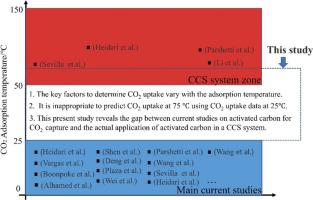Journal of CO2 Utilization ( IF 7.2 ) Pub Date : 2020-06-25 , DOI: 10.1016/j.jcou.2020.101214 Peng Yu , Zhongyang Luo , Qinhui Wang , Mengxiang Fang , Jiansheng Zhou , Wenbo Wang , Xiaorui Liang , Wenfei Cai

|
As potential CO2 adsorbents, carbon materials have recently gained attention because of their low energy penalty, abundant sources and good stability. In this study, the response surface methodology (RSM) was used to guide the pitch-based activated carbon preparation and CO2 adsorption at different temperatures. Based on this experimental design, the correlations of CO2 uptakes at different temperatures, as well as the coupling effects of the preparation conditions on CO2 uptake, were analyzed by mathematical modelling. The obtained optimal carbon sample AC650-1.25-2.5 showed a high atmospheric CO2 uptake of 3.15(±0.14), 2.05(±0.02), and 1.37(±0.11) mmol/g at 25 °C, 50 °C, and 75 °C, respectively. Furthermore, the analysis of variance confirmed that the key factor to determine CO2 uptake at 25 °C was the activator ratio, contributing to 77.8 % of the total variance; however, it gradually shifted to the activation temperature and its coupling effect with other factors for CO2 uptake at 75 °C. The linear regression and significance test of CO2 uptakes showed that using CO2 uptake at 25 °C to predict the uptake at 50 °C was feasible; however, it failed to work when predicting the CO2 uptake at 75 °C. The good linear relationship of CO2 uptakes at similar adsorption temperatures benefited from the existence of sharable effective pore width. It was also concluded that the strict requirement for extremely narrow ultra-micropores led to the non-coincidence of suitable preparation conditions, corresponding to a good CO2 uptake at different adsorption temperatures; this further led to the bad predictability when the adsorption temperature varied greatly.
中文翻译:

不同温度下活性炭基CO 2吸收评估:制备条件的相关性分析和耦合效应
作为潜在的CO 2吸附剂,碳材料因其低能量损失,丰富的来源和良好的稳定性而最近受到关注。在这项研究中,使用响应表面方法(RSM)来指导在不同温度下基于沥青的活性炭制备和CO 2吸附。基于该实验设计,通过数学建模分析了不同温度下CO 2吸收的相关性以及制备条件对CO 2吸收的耦合效应。获得的最佳碳样品AC650-1.25-2.5表现出较高的大气CO 2在25°C,50°C和75°C下分别吸收3.15(±0.14),2.05(±0.02)和1.37(±0.11)mmol / g。此外,方差分析证实,决定25°C下CO 2吸收的关键因素是活化剂比率,占总方差的77.8%。然而,它逐渐转移到活化温度及其与其他因素在75°C下吸收CO 2的耦合效应。CO 2吸收的线性回归和显着性检验表明,使用25°C的CO 2吸收量预测50°C的吸收量是可行的。但是,当预测在75°C下吸收CO 2时,它无法工作。CO 2的良好线性关系相似的吸附温度下的吸收量得益于可共享有效孔径的存在。还得出结论,对极窄的超微孔的严格要求导致不符合合适的制备条件,这对应于在不同的吸附温度下良好的CO 2吸收。当吸附温度变化很大时,这进一步导致不良的可预测性。











































 京公网安备 11010802027423号
京公网安备 11010802027423号